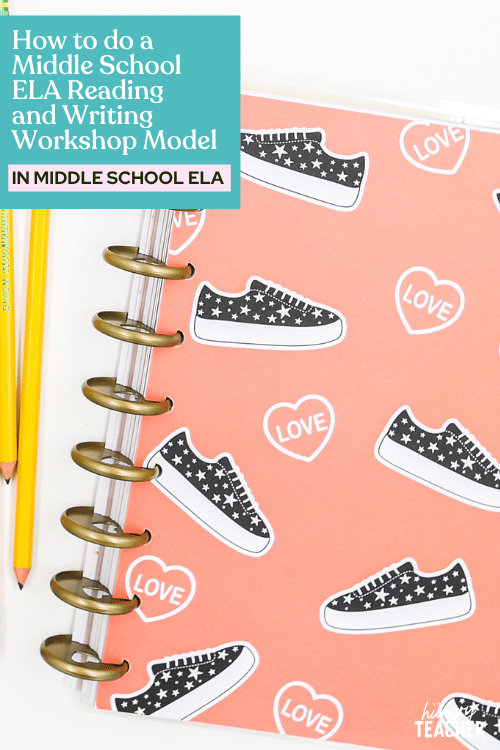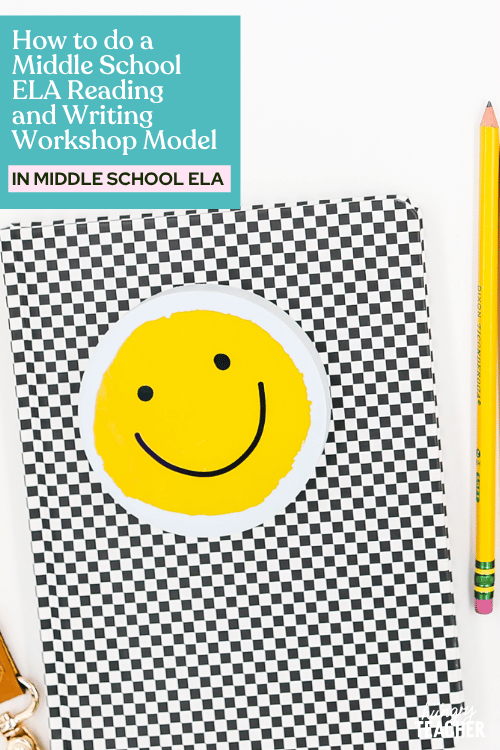hey friend!
I'm Martina.
I provide practical, time-saving strategies that actually work—so you can engage your students, teach effectively, and reclaim your time from the exhausting planning-grading cycle.
Browse Our ELA Resources
How to Do a Middle School ELA Reading and Writing Workshop Model
If you’ve ever wondered how to implement a reader’s workshop or writer’s workshop model in your classroom, I got you covered! Middle school ELA reading and writing workshop models are my go-to methods of teaching, and have allowed me to best utilize my time in the classroom.

What is the workshop model in teaching?
There are three parts to the workshop model in teaching: mini-lesson, workshop, and reflection. Here’s a breakdown of what this means:
Mini-Lesson – This is your whole group portion where you are teaching a mini-lesson, engaging in a class read-aloud, using interactive notebooks, or some other whole class activity where students learn and practice content.
Workshop – During the workshop, students are completing an independent activity related to the mini-lesson. You may also meet with students individually or in small groups during this time.
Reflection – This portion of the workshop model can be short and sweet. This is where students are able to share or reflect upon their work from the day. For example, this may be completing an exit ticket or talking in a small group.
Why use a middle school ELA workshop model?
The workshop model of teaching has become increasingly popular, but why should you use it? And is it right for your classroom?
Ultimately, you have to decide how you feel most comfortable teaching. I personally love the workshop model because it gives me time to meet with my students and assess their progress on a daily basis.
The workshop model also makes them responsible for their own learning. I could lecture for an entire class, but A) that would be exhausting and B) I would be doing all the work! Our students need to demonstrate what they have learned.

How to plan a reader’s and writer’s workshop
I wrote a blog a while back about what my classroom schedule looks like each day, but I want to talk specifically about how the middle school ELA reading and writing workshop model is incorporated into my class periods.
While reading and writing workshops have the same essential steps, they can look a little different due to the content.
Reading Workshop Model
For reader’s workshop, here is what your workshop might look like –
- A mini-lesson over a reading skill and then reading a short story or chapter as a whole group.
- A workshop where students answer reader’s response questions or another novel related activity. When students begin to finish their work, they read silently. During this time, you pull small groups or individual students to host reading conferences.
- For the reflection, ask students an exit ticket question or to turn and talk to their neighbor about the mini-lesson of the day.
Here is the hourly schedule I use for the reading workshop:
Here is an example of how this hourly schedule might look in my classroom for reader’s workshop:
- 5-10 minutes – Students look at the mentor sentence of the day and practice verb agreement.
- 15-20 minutes – As a class, we review plot diagrams and talk about climax. Then, we read the next chapter in our fiction book.
- 15-20 minutes – Independently, I have students fill out a plot diagram with the information we have so far. I call groups of students to my table and talk through it with them. I am mostly looking to see if they could identify the climax.
- 10-15 minutes – When students are done with their work, they read the next chapter in the book quietly to themselves. I continue to call students to my desk.
- 1 minute – I ask students to turn and talk to their neighbor and tell them how we can identify the climax of a story.
Writing Workshop Model
For writer’s workshop, here is what your workshop might look like –
- A mini-lesson that models and provides plenty of examples for a specific writing skill.
- During the workshop, students work independently on applying the writing skill from the mini-lesson to their own writing. Students are pulled individually or in groups to work on their writing.
- For the reflection, students will share what they wrote that day with a partner or group.
Here is the hourly schedule I use for writer’s workshop:
Here is an example of what writer’s workshop might look like during a literary analysis unit:
- 5-10 minutes – Students look at the mentor sentence of the day and practice diction.
- 15-20 minutes – I give a mini-lesson over thesis statements. I model for students and do a think-aloud. I also give my students several examples and sentence stems to use for crafting their own thesis.
- 15-20 minutes – Students then work on creating a thesis statement for their own piece of writing. While they work, I pull students individually to conference with them about the topic and thesis of their writing sample.
- 10 – 15 minutes – When students finish, they can silently read. I continue to pull students. Some students may still be writing at this point if they need more time.
- 2 minutes – I call on a few students to share their thesis statements with the class.
If you want to know more about the units and lessons I use for my middle school ELA reading and writing workshop models, check out my middle school ELA pacing guides! They are free and show you a yearly, weekly, and daily breakdown of what I teach my students.

Want a sneak peek at teaching The Hungry Teacher way—with support, structure, and strategy?
When you join the waitlist for The Hungry Teacher’s Hub membership, you get three free classroom-ready resources: a theme unit, an expository writing unit, and a grammar unit introducing mentor sentences. Plus, you’ll get immediate access to a selection of exclusives from the Hub, including editable sub plans, pacing guides, and more.
No strings attached. Just resources you can use right now—and a heads-up when the Hub opens.
3 Free Middle School ELA Units—yours to keep!
JOIN THE WAITLIST + A FREE GIFT
Where to next, line leader?
Welcome to The Hungry Teacher! We create resources that are easy to use, practical, and get results. Teach with confidence—and make it home before dinner.
xo, the hungry teacher